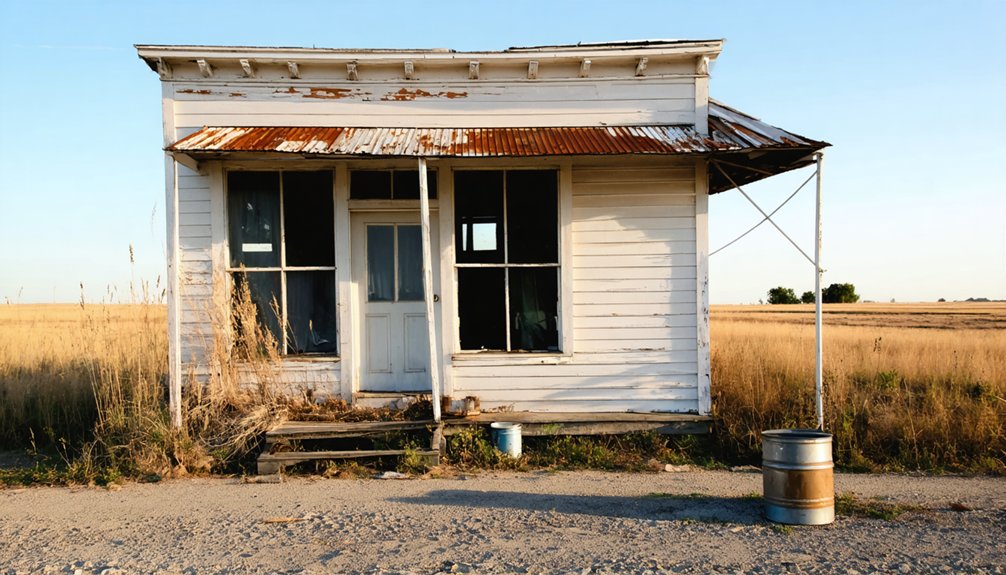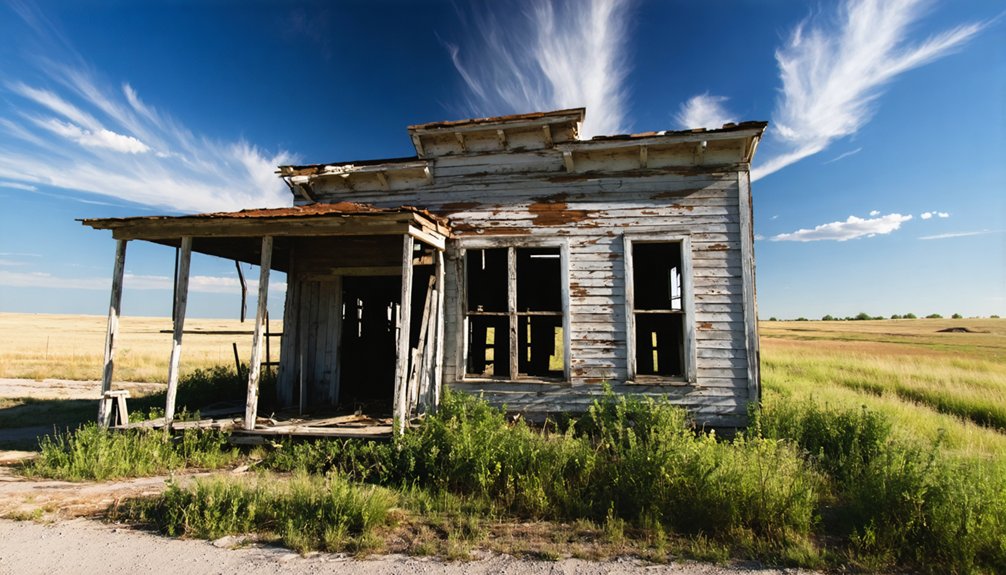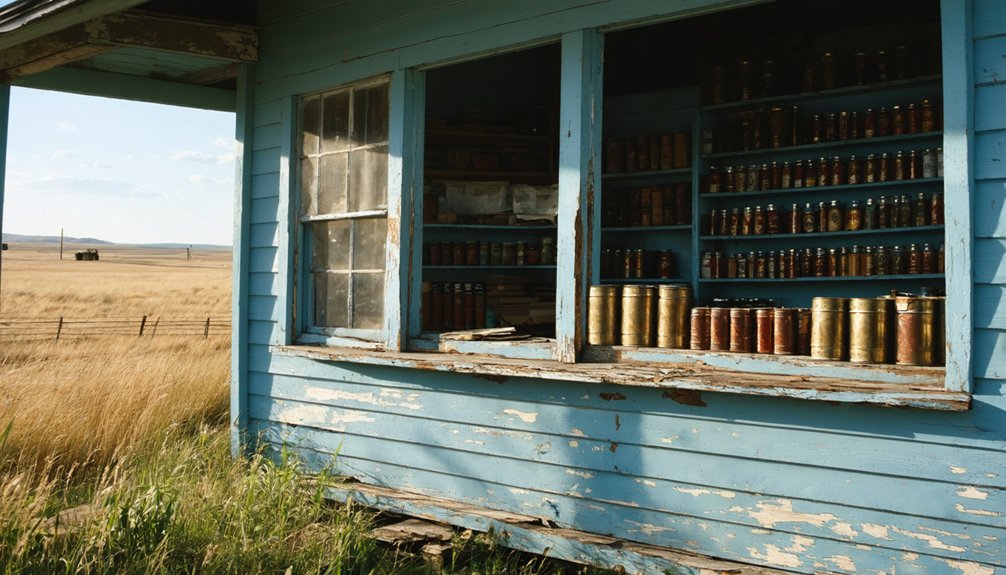You’ll discover Dansby among South Dakota’s Black Hills ghost towns, established during the 1874 gold rush after Custer’s expedition. The frontier settlement thrived through mining operations, with the nearby Homestake Mine producing $720 million in gold over a century. The town featured classic frontier architecture along its main street and rail depot, supporting a diverse community of miners until depleted gold deposits and discontinued railroad service led to its abandonment. Its remaining legacy tells a compelling story of frontier resilience and ambition.
Key Takeaways
- Dansby emerged as a gold rush town in South Dakota’s Black Hills following Lt. Colonel Custer’s 1874 discovery of gold at French Creek.
- The town’s economy centered around mining operations, with the Homestake Mine producing $720 million in gold over a century.
- Daily life featured dawn-to-dusk mining work, vibrant community gatherings, and a mix of cultural groups including Danish, Black, and Chinese workers.
- Dansby declined due to depleted gold deposits, mine closures, and discontinued railroad service, leading to widespread abandonment.
- Few physical remains exist today, though the town’s legacy provides important insights into Black Hills frontier development and mining history.
The Rise of a Black Hills Mining Settlement
When Lt. Colonel George Custer‘s 1874 expedition discovered gold at French Creek, you’d have witnessed the start of a transformative era in the Black Hills.
The discovery, though violating the Fort Laramie Treaty with the Sioux, sparked a rapid influx of fortune seekers to the region. The military’s attempts to control the situation proved futile as thousands of miners poured into the territory. The Homestake Mine would eventually produce $720 million in gold over a century of operations. You’ll find that early mining settlements sprang up around French Creek and Deadwood Creek, where placer mining technology initially dominated the landscape.
The economic hardships of the 1873 Panic drove remarkable labor diversity to these settlements, including black and Chinese workers seeking opportunity.
Mining camps quickly evolved into supply centers, connected by transport routes to Yankton, Bismarck, Cheyenne, and Sidney.
While many claims proved short-lived as placer deposits depleted, the settlements that survived became essential hubs in the Black Hills’ gold rush story.
Life in Early Dansby
You’ll find that daily life in early Dansby revolved around the rhythms of mining work, with residents rising before dawn to begin their shifts in the nearby mines and mills.
Young Danish couples sought new opportunities in Dakota Territory during the 1870s and 1880s, joining the stream of hopeful settlers heading west for a fresh start.
Similar to how Danish settlers gathered at the Danish Brotherhood Society in Viborg years later, the town’s sense of community flourished through regular gatherings at the local meeting hall, where families would come together for social events, dances, and holiday celebrations.
Despite the harsh working conditions, these shared moments of leisure and fellowship helped strengthen the bonds between Dansby’s residents, creating a close-knit mining community typical of Black Hills settlements.
Daily Mining Town Routines
Life in early Dansby revolved around the demanding rhythms of placer mining operations, where miners worked from dawn until dusk extracting gold from creek beds.
You’d find miners crushing rock and using mercury amalgamation, their daily routines centered on maintaining sharp tools and efficient sluice boxes to maximize gold recovery.
If you’d visited this bustling mining town, you’d have seen scattered cabins and tents dotting the landscape, with shared wash houses and outhouses serving the community.
You’d need to carefully manage your supplies, as deliveries of food and tools arrived sporadically by stagecoach.
Teams of miners would work together, sharing the burden of hauling ore and running water flumes, while taking brief breaks for tobacco and meals to maintain their strength through the grueling workday.
Like many ghost town hunters today, visitors had to use patience and careful observation to locate promising mining claims.
The discovery of major deposits in Deadwood Gulch in 1875 drew many miners away from smaller claims in towns like Dansby.
Community Gatherings and Events
Beyond the daily grind of mining operations, Dansby’s residents found warmth and connection through vibrant community gatherings.
You’d find townspeople congregating in social halls, churches, and saloons, where community activities ranged from lively dances to casual card games. During tough times, you’d witness neighbors helping neighbors through barn raisings, harvest assistance, and emergency support.
The town’s social traditions centered around seasonal celebrations, with Fourth of July and Christmas bringing everyone together. Like many South Dakota towns, Dansby’s dance halls were remembered fondly by former residents who moved away. The town maintained a strong sense of unity until the Great Depression devastated the local economy.
You could join Sunday church services that doubled as social events, or participate in fundraising dances to help families in need. The schoolhouse hosted educational meetings and town assemblies, while annual fairs and festivals celebrated local culture.
Music, storytelling, and shared meals strengthened the bonds that kept this mining community resilient.
Mining Operations and Railroad Connections
Mining operations in Dansby reached impressive depths, with the Ellison Shaft extending to 1,550 feet by 1906 and later operations plunging to 8,000 feet below ground.
The daring miners of Dansby ventured ever deeper, from 1,550-foot shafts in 1906 to staggering 8,000-foot depths in later years.
Massive infrastructure development required over 800,000 bricks to construct the imposing head frame structure that defined Dansby’s mining landscape.
The evolution of mining technology transformed the region, as compressed air locomotives replaced animal haulage in the 1920s, and Charles Merrill’s cyanidization process boosted gold recovery rates to 94%. The discovery of gold in French Creek initially sparked the region’s mining boom that would shape towns like Dansby.
You’ll find that railroad expansion played a vital role in Dansby’s mining success. The rail networks connected mine shafts to processing facilities, enabling efficient ore transport to distant refineries like the Denver Mint.
Strategic placement of shafts near railroad infrastructure maximized operational efficiency, while gravity-assisted ore flow systems on hillsides streamlined the transfer to rail-connected milling complexes.
Daily Commerce and Community Spirit
While Dansby’s bustling mines drove the town’s economy, its vibrant commercial district served as the heartbeat of daily life.
You’d find an array of local businesses, from the general store stocked with essential supplies to the blacksmith’s shop ringing with the sound of metal on metal. The town’s saloons and gathering spots fostered a spirit of camaraderie, while the post office kept you connected to the outside world.
- The general store wasn’t just a shop – it was your lifeline to supplies, news, and neighborly conversation.
- Community resilience showed in seasonal celebrations and shared hardships, binding residents together.
- Local services, from medical care to banking, helped you maintain independence in this frontier setting.
Architecture and Infrastructure

The architectural landscape of Dansby captured the resourceful spirit of late 19th century frontier living.
You’ll find the town’s building styles were primarily wood-frame constructions, featuring simple one- and two-room cottages alongside essential structures like the general store, post office, and saloon. Local timber and basic construction techniques defined these humble yet functional buildings.
The infrastructure layout followed the classic frontier town design, with development concentrated along the main street near the rail line. The train depot served as a crucial hub, while public spaces anchored the community’s social life.
You can still spot remnants of stone foundations and building footings, though many structures were later relocated to Glenham. What remains today stands weathered and mostly abandoned, a reflection of the impermanence of frontier settlements.
The Path to Abandonment
You’ll find that Dansby’s decline began with the inevitable exhaustion of profitable gold deposits, leading to the closure of mines that had sustained the town since its inception.
The loss of mining operations triggered a swift economic downturn as unemployed workers and their families left to seek opportunities elsewhere.
When the railroad company discontinued service to Dansby due to reduced freight and passenger demand, the town’s isolation and economic stagnation became insurmountable challenges.
Mining Industry Collapse
Mining operations in Dansby faced a perfect storm of challenges that ultimately led to the town’s abandonment. You’ll find that the economic decline stemmed from depleted high-grade ore deposits, forcing miners to extract from less profitable sources.
As mining technology evolved to process lower-grade ore, the increased operational costs and complexity overwhelmed many local mines.
- The shift from simple placer mining to capital-intensive hard rock operations demanded substantial investments that many companies couldn’t sustain.
- Environmental regulations and oversight fees added financial burdens, while fluctuating gold prices made profitability uncertain.
- Competition from richer gold deposits elsewhere drew away essential investment capital, making it impossible for Dansby’s mines to modernize and survive.
These combined pressures eventually forced mining operations to close, leaving Dansby’s economy without its lifeblood.
Railroad Services End
Following mining’s collapse, railroad services proved to be another fatal blow to Dansby’s survival.
You’ll find that post-World War II railroad decline hit small towns like Dansby particularly hard, as automobiles and trucks increasingly dominated transportation. The loss of rail service effectively cut off Dansby’s essential lifeline to larger markets and neighboring communities.
Without its railroad connection, Dansby faced severe economic isolation. You could see the impact as grain elevators and warehouses, once bustling with activity, fell silent.
The town’s telegraph office, which had kept residents connected to the outside world, ceased operations. The Dakota Southern Railway’s eventual abandonment of local lines sealed Dansby’s fate, making it nearly impossible for the remaining residents to sustain their livelihoods, ultimately accelerating the town’s descent into abandonment.
What Remains Today

Today’s visitors to Dansby, South Dakota will find little evidence of the once-established settlement, as the ghost town has been reduced largely to rubble and partial ruins. A remnants assessment reveals no intact commercial or residential structures, with only scattered foundations hinting at the town’s former layout.
Nature has reclaimed the site, transforming it into open pastureland where native vegetation overtakes the few remaining structural footprints.
- You’ll encounter an untamed landscape free from modern infrastructure, offering a raw glimpse into the region’s past.
- The site’s remoteness and lack of facilities lets you explore without tourist crowds or restrictions.
- Your visit provides a stark reminder of how quickly civilization can fade when abandoned to the elements.
Exploring Dansby’s Historical Legacy
While little physical evidence remains of Dansby’s existence, the town’s historical legacy offers a fascinating window into South Dakota’s frontier development during the late 19th century.
You’ll discover Dansby’s historical significance through its role in the region’s economic evolution, particularly in mining, timber, and railroad operations that shaped the Black Hills area.
The town’s cultural heritage lives on through descendants’ oral histories, preserving stories of resilient frontier families who built their lives around resource extraction and transportation industries.
You can trace Dansby’s journey from a bustling hub of approximately 100 residents to its eventual decline, mirroring the broader pattern of boom-and-bust cycles that defined many Black Hills settlements.
Its story exemplifies the entrepreneurial spirit and challenges faced by early South Dakota pioneers.
Preserving the Past for Future Generations

Preserving Dansby’s historical legacy requires a careful balance of legal standards, community engagement, and practical safety considerations.
As you explore opportunities for historical preservation, you’ll find support through grants and loans from the Deadwood Historic Preservation Commission, particularly if you own property in the area.
Your efforts must align with National Park Service standards while addressing structural deterioration and safety hazards common in ghost towns.
- Your involvement in community engagement initiatives helps document essential oral histories and verify historical records.
- You’ll need to navigate preservation challenges while maintaining authentic materials and features that define Dansby’s character.
- You’re contributing to South Dakota’s heritage by supporting preservation efforts that connect present and future generations to the past.
Frequently Asked Questions
Were There Any Notable Crimes or Lawlessness Incidents in Dansby’s History?
Like a dusty page missing from history’s book, you won’t find notable crime rates or major lawlessness documented in Dansby, though typical mining-town disorder existed before law enforcement arrived.
What Native American Tribes Originally Inhabited the Area Before Dansby’s Establishment?
You’ll find the region was primarily inhabited by the Lakota Sioux tribes, who dominated the western plains. Earlier evidence suggests Cheyenne Tribe settlements existed before the Lakota’s rise to prominence.
Did Any Famous Historical Figures Ever Visit or Stay in Dansby?
You won’t find any records of famous visitors in Dansby’s history. Unlike neighboring towns with documented historical significance, there’s no evidence that any notable figures ever stopped in this small settlement.
What Were the Most Common Causes of Death Among Dansby Residents?
You’d find disease outbreaks like influenza and bowel inflammation, along with industrial accidents in mines and sawmills, were leading causes of death in the harsh frontier conditions.
Were There Any Significant Natural Disasters That Affected Dansby?
You won’t find any documented major natural disasters specific to Dansby, though the area experienced typical Black Hills flood impacts and potential fire damage common to regional mining towns.
References
- https://www.youtube.com/watch?v=Glucs_Rq8Xs
- https://www.sdhspress.com/journal/south-dakota-history-2-2/some-black-hills-ghost-towns-and-their-origins/vol-02-no-2-some-black-hills-ghost-towns-and-their-origins.pdf
- https://www.sdpb.org/rural-life-and-history/2023-08-21/some-black-hills-ghost-towns-and-their-origins
- https://www.youtube.com/watch?v=_0WNYsFLSLA
- https://www.powderhouselodge.com/black-hills-attractions/fun-attractions/ghost-towns-of-western-south-dakota/
- https://icatchshadows.com/okaton-and-cottonwood-a-photographic-visit-to-two-south-dakota-ghost-towns/
- https://en.wikipedia.org/wiki/List_of_ghost_towns_in_South_Dakota
- https://www.ebsco.com/research-starters/history/black-hills-gold-rush
- https://www.americanhistorycentral.com/entries/black-hills-gold-rush/
- https://blackhillsminingmuseum.com/learn/history



